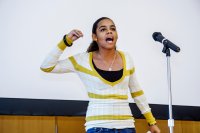When Girls Spit: The Power of Spoken Word
Encouraging young women of color to express their experiences creatively through spoken word can empower them.
Your content has been saved!
Go to My Saved Content.In today’s society, we have seen the power of words. Words that heal, and words that destroy. Words that promote fear, and words that promote change.
Our words matter.
Spoken word can be used as one of many pedagogical tools that will encourage girls of color to speak their “herstories” in ways that privilege their cultural knowledge and brilliance in school.
Spoken word is especially important for girls of color, who are more likely to receive out-of-school punishments than white female students and are more likely to be suspended or arrested. Girlhood Interrupted: The Erasure of Black Girls’ Childhood, a 2017 publication from the Georgetown Law Center on Poverty and Inequality, reported that the adultification of minority girls begins as early as 5 years old.
Culturally Sustainable Practice
Culturally sustainable pedagogy, according to Dr. Django Paris, is a practice that draws from the cultural knowledge and experiences of students of color while also seeking to challenge, support, and maintain their cultural, racial, linguistic, and historical narratives. Spoken word does just that.
When girls “spit,” or use spoken word, they are able to redefine the boundaries of language in the classroom while promoting leadership and self-advocacy. Spoken word is an instrument of change that binds the arts, literature, and poetry by bringing youth culture front and center in the classroom.
At a high school in Kansas, I cofounded a spoken word curriculum focused on the academic, social and emotional, and trauma-informed needs of girls of color. Each class session, the girls looked forward to learning and seeing the brilliance of women and girls who looked like them. Several strategies were effective in implementing our spoken word curriculum.
Selecting Texts
Having one person or woman of color in a textbook does not fully value their cultural and historical narratives in the classroom. We cannot teach Rosa Parks alone. Our program uses works from bell hooks, Alice Walker, and Maya Angelou to give the girls concrete examples of the possibilities of spoken word. Intentionally selecting resources relevant to the girls’ racial and gendered experiences allowed them to find themselves within the texts.
Encourage students to make connections between what they’re reading and their own lives. Allow students to bring their own poetry, musical lyrics, and culture into the classroom.
Participate in the dialogic process by reading with students. In our program, we shared our own life stories of marginalization, vulnerability, and triumph. Using a curriculum that legitimized and humanized the lived experiences of women of color demonstrated that we valued our students.
Take the Classroom to the Community
Seek out a range of resources beyond the classroom. For example, our program partnered with a local university to take students on field trips to campus to hear renowned black poets.
One student in the program was in 10th grade, and the field trip was her first time seeing a college campus. Before moving to Kansas, she had been in an alternative school in Florida and had been expelled from another middle school. The student read Nikki Giovanni’s work and then met her on campus during the field trip. After the trip, the student said, “I never knew black women could be professors, have the freedom to speak like that, be herself—and it was OK.”
Educators can partner with students and serve as a supportive community as they and lead spoken word slams, which allow students to address social issues in their communities and in society while telling their narratives. We supported our students’ efforts to perform their spoken word in front of their peers and at community events. You might consider collaborating with neighborhood organizations so students can perform their spoken word at community centers, youth hangouts, or a local library.
Fill the Imagination Gap
An imagination gap exists when students lack spaces that promote creativity, self-expression, and the development of ideas. Educators can encourage students to create tension within texts by engaging in critical thinking and spoken word analysis.
For example, educators and students can ask questions such as: How do race and gender intersect in a particular content area? What are the future possibilities for girls who look like me in math, science, social studies, and civics?
Make Spoken Word an Acceptable Language
Develop students’ public speaking and creative ability by replacing a deficit-oriented lens with one that appreciates strong racial and cultural bonds with students, parents and/or guardians, and the community.
Still, strategies are not enough. Educators will need to confront and address their own implicit and explicit biases and their own racial illiteracy.
Spoken work can be used to engage educators and students in the classroom, but it will also allow girls of color to:
